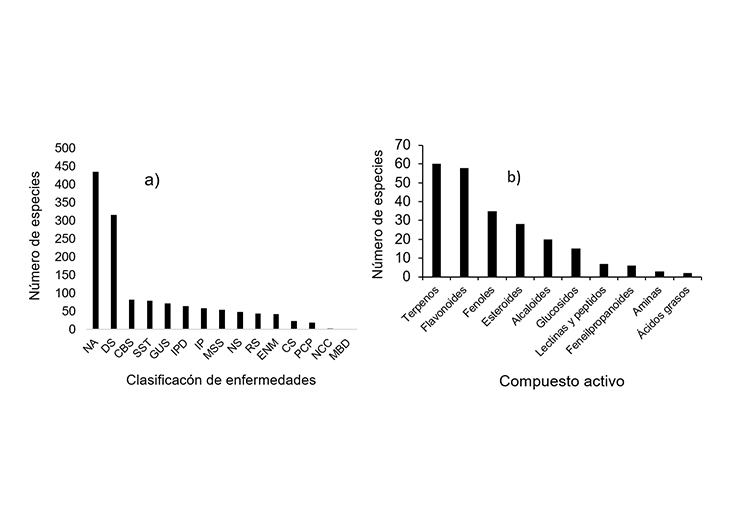Medicinal flora of Oaxaca, Mexico: a review
DOI:
https://doi.org/10.29312/remexca.v16i6.3827Keywords:
active compounds, ethnomedicine, native peoplesAbstract
Medicinal plants are the first resource for global access to health. In Oaxaca, these resources have been used since pre-Hispanic times. The objective was to integrate the available information on the use of medicinal plants in the state of Oaxaca, including the region and ethnic group that uses them, the conditions they combat, the active compounds they contain, and their conservation status in NOM-059-SEMARNAT-2010. A search was conducted for scientific articles and floristic reports that inform about the presence of medicinal plants in the state in the ScienceDirect, Springer, Google Scholar, and Mendeley databases. The references were sorted and analyzed in Excel. Spearman correlation tests were performed with the SAS statistical package. A total of 1 056 medicinal species were identified, 150 belonging to the family Asteraceae and 69 to the family Fagaceae. A total of 485 were found in the Sierra Norte, and 312 in the Valles Centrales. The Zapotecs are the ones who use them the most, followed by the Chinantecs and Mazatecs. There are 316 species that are used to treat gastrointestinal problems. The state of Oaxaca has a high biological and cultural diversity that is reflected in the number of medicinal species used and the knowledge kept by the communities in which they are located.
Downloads
References
Aparicio-Aparicio, J. C.; Voeks, R. A. and Silveira-Funch, L. 2021. Are Mixtec forgetting their plants? intracultural variation of ethnobotanical knowledge in Oaxaca, Mexico. Economic Botany. 75(3-4):215-233. https://doi.org/10.1007/s12231-021-09535-2.
Alonso-Castro, A. J.; Domínguez, F.; García-Regalado, I.; González-Sánchez, M.; Cerbón, A. and García-Carrancá, A. 2014. Magnolia dealbata seeds extract exerts cytotoxic and chemopreventive effects on MDA-MB231 breast cancer cells. Pharmaceutical Biology. 52(5):621-627. https://doi.org/10.3109/13880209.2013.859160.
Casselman, I.; Nock, C. J.; Wohlmuth, H.; Weatherby, R. P. and Heinrich M. 2014. From local to global fifty years of research on Salvia divinorum. Journal of Ethnopharmacology. 151(2):768-783. Elsevier Ireland Ltd. https://doi.org/10.1016/j.jep.2013.11.032.
CIE-11. 2019. Clasificación Internacional de Enfermedades. Guía de referencia. 404 p. https://icd.who.int/es/docs/Guia%20de%20Referencia%20(version%2014%20nov%202019).pdf.
CONABIO. 2025. Sistema Nacional de Información sobre Biodiversidad. Comisión Nacional para el Conocimiento y Uso de la Biodiversidad, México. https://enciclovida.mx/.
Cruz-Pérez, A. L.; Barrera-Ramos, J.; Bernal-Ramírez, L. A.; Bravo-Avilez, D. and Rendón-Aguilar B. 2021. Actualized inventory of medicinal plants used in traditional medicine in Oaxaca, Mexico. Journal of Ethnobiology and Ethnomedicine. 17(1):1-15. https://doi.org/10.1186/s13002-020-00431-y.
Fernández-Flores, A. and Llamas, V. A. 2020. Guarumbo cecropia obtusifolia for warts in Zapotec Medicine. Actas Dermosifiliogr. 111(3):189-19.
García-Mendoza, A. J.; Meave, J. A. 2011. Diversidad florística de Oaxaca: de musgos a angiospermas (colecciones y lista de especies). Primera edición. Universidad Nacional Autónoma de México-CONABIO, México, DF. 351p.
Kachmar, M. R.; Naceiri-Mrabti, H.; Bellahmar, M.; Ouahbi, A.; Haloui, Z.; El-Badaoui, K.; Bouyahya, A. and Chakir, S. 2021. Traditional knowledge of medicinal plants used in the northeastern part of Morocco. Evidence based complementary and alternative medicine. 6(2021):1-20. Hindawi Limited. https://doi.org/10.1155/2021/6002949.
Kujawska, M. and Schmeda-Hirschmann, G. 2022. The use of medicinal plants by Paraguayan migrants in the Atlantic Forest of Misiones, Argentina, is based on Guaraní tradition, colonial and current plant knowledge. Journal of Ethnopharmacology. 283(30):1-26. https://doi.org/10.1016/j.jep.2021.114702.
Leyva-Castañeda, D.; Sígala-Rodríguez, J. and Ocampo, G. 2020. Species richness estimation of the Asteraceae family in four areas for conservation from central Mexico using non-parametric methods to measure biodiversity. Botanical Sciences. 98(2):317-327. https://doi.org/10.17129/botsci.2552.
López-Caamal, A. and Reyes-Chilpa R. 2021. The new world bays (Litsea, Lauraceae). A botanical, chemical, pharmacological and ecological review in relation to their traditional and potential applications as phytomedicines. Botanical Review. 87(3):392-420. Springer. https://doi.org/10.1007/s12229-021-09265-z.
Macêdo, M. J. F.; Ribeiro, D. A.; Santos, M. O.; Macêdo, D. G.; Macedo, J. G. F.; Almeida, B. V.; Saraiva, M. E.; Lacerda, M. N. S. and Souza, M. M. 2018. Fabaceae medicinal flora with therapeutic potential in Savanna areas in the Chapada do Araripe, Northeastern Brazil. Revista Brasileira de Farmacognosia. 28(6):738-750. https://doi.org/10.1016/j.bjp.2018.06.010.
Madhavan, M. S. T. and Tharakan, S. T. 2020. Total phenol quantification and anthelmintic activity of Sarcostemma acidum. Journal of Pharmaceutical Sciences and Research. 12(1):28-30. https://www.jpsr.pharmainfo.in/Documents/Volumes/vol12issue01/jpsr12012005.pdf.
Martínez-López, G.; Guízar-Nolazco, E.; Villanueva-Morales, A. y Palacios-Rangel, M. I. 2021. Usos locales y tradición: estudio etnobotánico de plantas útiles en San Pablo cuatro venados Valles Centrales, Oaxaca. Polibotánica. 52(1):1-20. https://doi.org/10.18387/polibotanica.52.13.
Nodar, J. 2020. The worldview of the Zapotecs of the Sierra sur of Oaxaca Mexico and the comparative environmental ethics. Indiana. 37(2):303-322. Doi. 10.18441/ind.v37i2.303-322.
Palsson, O. S. and Whitehead, W. E. 2013. Psychological treatments in functional gastrointestinal disorders: a primer for the gastroenterologist. Clinical Gastroenterology and Hepatology. 11(3):208-216. https://doi.org/10.1016/j.cgh.2012.10.031.
Pascual-Mendoza, S.; Saynes-Vásquez, A. and Pérez-Herrera, A. 2022. Traditional knowledge of edible plants in an indigenous community in the Sierra Norte of Oaxaca, Mexico. Plant Biosystems. 156(2):515-527. https://doi.org/10.1080/11263504.2021.1887956.
Pérez-Lara, D. K.; Estrada-Ruiz, E. and Castañeda-Posadas, C. 2019. New fossil woods of Fabaceae from El bosque formation, Chiapas, Mexico. Journal of South American Earth Sciences. 94:1-8. https://doi.org/10.1016/j.jsames.2019.05.018.
Pérez-Ochoa, L. M.; Luis-Chávez, S. J.; Vera-Guzmán, M. A.; Aquino-Bolaños, N. E. and Cruz-Carrillo, R. J. 2019. Medicinal plants used by indigenous communities of Oaxaca, Mexico, to treat gastrointestinal disorders. In: Pharmacognosy Medicinal Plants. 1-36 pp. https://doi.org/10.5772/intechopen.82182.
Piña-Alcántara, S. 2019. Turismo y chamanismo, dos mundos imbricados: el caso de Huautla de Jiménez, Oaxaca. Revista de Ciencias Antropológicas. 75(1):43-66. https://www.scielo.org.mx/pdf/crca/v26n75/0185-1659-cuicui-26-75-43.pdf.
Rahman, M. D.; Roy, H. B.; Chowdhury, G. M.; Hasan, A. and Saimun, S. R. 2022. Medicinal plant sources and traditional healthcare practices of forest-dependent communities in and around Chunati wildlife sanctuary in southeastern Bangladesh. Environmental Sustainability. 5(2):207-241. https://doi.org/10.1007/s42398-022-00230-z.
Rolnik, A.; Stochmal, A. and Olas, B. 2022. The in vitro anti-platelet activities of plant extracts from the Asteraceae family. Biomedicine and Pharmacotherapy. 149(112809):1-8. https://doi.org/10.1016/J.BIOPHA.2022.112809.
Sathishkumar, P.; Gu, F. L.; Zhan, Q.; Palvannan, T. and Mohd-Yusoff, A. R. 2018. Flavonoids mediated ‘Green’ nanomaterials: a novel nanomedicine system to treat various diseases current trends and future perspective. Materials Letters. 210(1):26-30. https://doi.org/10.1016/j.matlet.2017.08.078.
SEMARNAT. 2010. Secretaría de Medio Ambiente y Recursos Naturales. Norma oficial mexicana NOM-059-SEMARNAT. Protección ambiental especies nativas de México de flora y fauna silvestres categorías de riesgo y especificaciones para su inclusión, exclusión o cambio lista de especies en riesgo. 78 p. https://www.profepa.gob.mx/innovaportal/file/435/1/NOM-059-SEMARNAT-2010.pdf.
Serralta-Batun, L. P.; Jiménez-Osornio, J. J.; Munguía-Rosas, M. Á. and Rodríguez-Robayo, K. J. 2023. Threats to the traditional agricultural landscape of southern Yucatan, Mexico: a perspective from the socioecological analysis. Revista de Economía e Sociología Rural. 62(1):1-20. https://doi.org/10.1590/1806-9479.2022.265073.
Strong, K.; Noor, A.; Aponte, J.; Banerjee, A.; Cibulskis, R.; Diaz, T.; Ghys, P.; Glaziou, P.; Hereward, M.; Hug, L.; Kantorova, V.; Mahy, M.; Moller, A.; Requejo, J.; Riley, L.; Say, L. and You, D. 2020. Monitoring the status of selected health related sustainable development goals: methods and projections to 2030. Global Health Action. 13: 1-14. https://doi.org/10.1080/16549716.2020.1846903.
Tang, Q.; Xu, F.; Wei, X.; Gu, J.; Qiao, P.; Zhu, X.; Yin, S.; Ouyang, D.; Dong, J.; Yao, J.; Wang, Y. and Chen, J. 2023. Investigation of β-caryophyllene as terpene penetration enhancer: role of stratum corneum retention. European Journal of Pharmaceutical Sciences. Official Journal of the European Federation for Pharmaceutical Sciences. 183:112. https://doi.org/10.1016/j.ejps.2023.106401.
Valdivia-Correa, B.; Gómez-Gutiérrez, C.; Uribe, M. and Méndez-Sánchez, N. 2016. Herbal medicine in Mexico: a cause of hepatotoxicity. A critical review. International Journal of Molecular Sciences. 17(2):17020235-10. https://doi.org/10.3390/ijms17020235.
Zhao, F.; Chen, Y. P.; Salmaki, Y.; Drew, B. T.; Wilson, T. C.; Scheen, A. C.; Celep, F.; Bräuchler, C.; Bendiksby, M.; Wang, Q.; Min, D. Z.; Peng, H.; Olmstead, R. G.; Li, B. and Xiang, C. L. 2021. An updated tribal classification of Lamiaceae based on plastome phylogenomics. BMC Biology. 19(2):1-27. https://doi.org/10.1186/s12915-020-00931-z.

Published
How to Cite
Issue
Section
License
Copyright (c) 2025 Revista Mexicana de Ciencias Agrícolas

This work is licensed under a Creative Commons Attribution-NonCommercial 4.0 International License.
The authors who publish in Revista Mexicana de Ciencias Agrícolas accept the following conditions:
In accordance with copyright laws, Revista Mexicana de Ciencias Agrícolas recognizes and respects the authors’ moral right and ownership of property rights which will be transferred to the journal for dissemination in open access. Invariably, all the authors have to sign a letter of transfer of property rights and of originality of the article to Instituto Nacional de Investigaciones Forestales, Agrícolas y Pecuarias (INIFAP) [National Institute of Forestry, Agricultural and Livestock Research]. The author(s) must pay a fee for the reception of articles before proceeding to editorial review.
All the texts published by Revista Mexicana de Ciencias Agrícolas —with no exception— are distributed under a Creative Commons License Attribution-NonCommercial 4.0 International (CC BY-NC 4.0), which allows third parties to use the publication as long as the work’s authorship and its first publication in this journal are mentioned.
The author(s) can enter into independent and additional contractual agreements for the nonexclusive distribution of the version of the article published in Revista Mexicana de Ciencias Agrícolas (for example include it into an institutional repository or publish it in a book) as long as it is clearly and explicitly indicated that the work was published for the first time in Revista Mexicana de Ciencias Agrícolas.
For all the above, the authors shall send the Letter-transfer of Property Rights for the first publication duly filled in and signed by the author(s). This form must be sent as a PDF file to: revista_atm@yahoo.com.mx; cienciasagricola@inifap.gob.mx; remexca2017@gmail.
This work is licensed under a Creative Commons Attribution-Noncommercial 4.0 International license.


